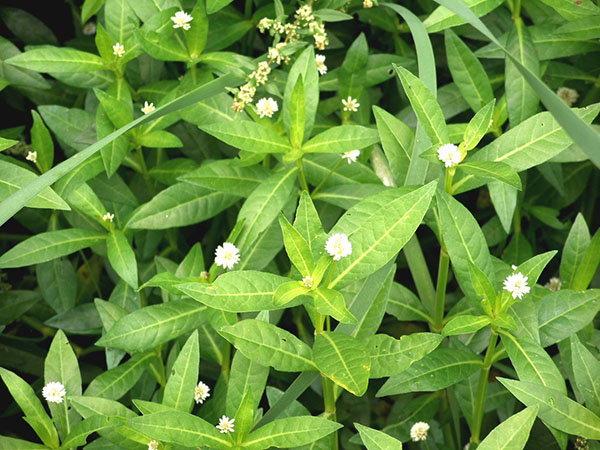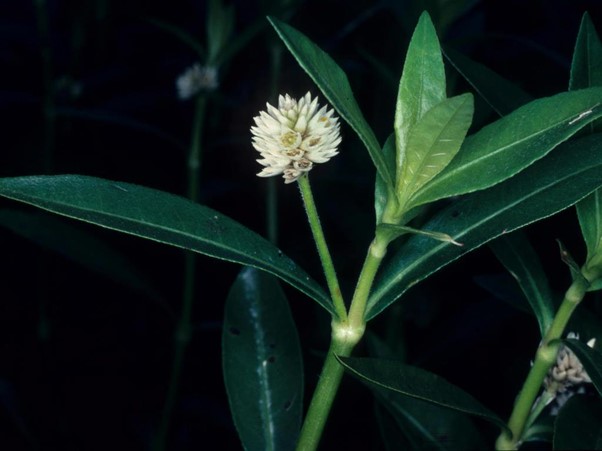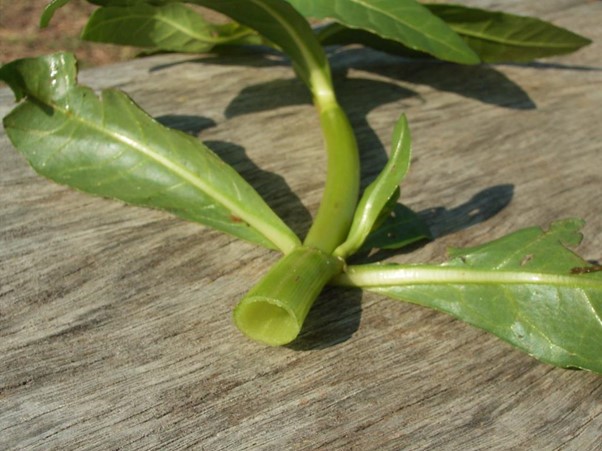Alligator Weed
Alligator Weed is a priority weed due to the impact it can have on both aquatic and terrestrial environments.
Alligator weed has major impacts on irrigated agriculture through competition with crops and pastures, blocking of waterways, and damage to irrigation infrastructure. It forms dense mats of stems that hinder light penetration causing de-oxygenation and increased sedimentation.

How to identify Alligator Weed?
Alligator weed is a summer growing perennial herb. It has small white, papery flower heads 8–10 mm in diameter, generally appearing from November to March. Its leaves are shiny, spear-shaped, with no stalk, about 2–7 cm long and 1–2 cm wide and occur in opposite pairs along the stems.

 The plant forms large, dense mats of interwoven creeping and layering stems. Over water, stems grow to 60 cm high and up to 10 m long and have large, hollow internodes. It has a hollow stem that makes a “pop” noise when it cracks.
The plant forms large, dense mats of interwoven creeping and layering stems. Over water, stems grow to 60 cm high and up to 10 m long and have large, hollow internodes. It has a hollow stem that makes a “pop” noise when it cracks.
Alligator weed has an extensive root system. Roots are fine and short in water but become thicker and starchy in soil, able to penetrate to depths of over 50 cm.
Why is Alligator Weed a problem?
Alligator weed disrupts the aquatic environment by blanketing the surface and impeding the penetration of light. This can lead to anaerobic conditions, which adversely affects aquatic flora and fauna. It also competes with and displaces native flora along river and creek banks and in wetlands.
Negative environmental impacts include:
- Outcompetes native vegetation and is a threat to biodiversity.
- Eliminates small crops and turf farms.
- Blocks and damages pumps and other water infrastructure, restricting water access.
- It can cause photosensitisation in cattle and lambs when grazed.
How does Alligator Weed spread?
Alligator Weed does not reproduce by seed, instead it is capable of growing from any plant fragments. It is easily dispersed through excavation, boating and sand dredging on waterbodies. It can also disperse through movement of soil or turf and spread on machinery and stock hooves.
How to prevent the spread of Alligator Weed
Physical removal (being careful to avoid fragmentation), biological and chemical control are important weed biosecurity practices.
Using a weed hygiene station to properly clean the bottom and sides of your footwear. Thoroughly hose vehicles and machinery. Brush down your clothing. Brush or hose any hard to reach areas. Thoroughly brush down all of your equipment.
What to do if you suspect Alligator Weed on your property?
Alligator weed is a high priority species in the Murray and Riverina regions and is a reportable plant.
If you see this plant, let us know!
Contact your Local Council Biosecurity (weed officer) – there are a couple of ways you can do this:
Phone - via the Local Council head office number
Online enquiry form – only applicable to some councils
Apps – only applicable to some councils
Alternatively, you can contact the NSW DPI Biosecurity Helpline on 1800 680 244, or send an email (including photo if you have one) to weeds@dpi.nsw.gov.au.
For more information - NSW WeedWise
Thanks to Petaurus Education Group and our local council weed officers at Greater Hume Shire Council for this feature video: